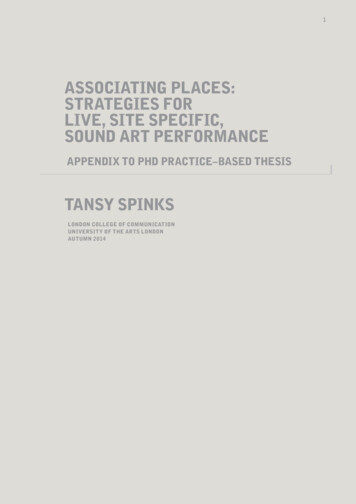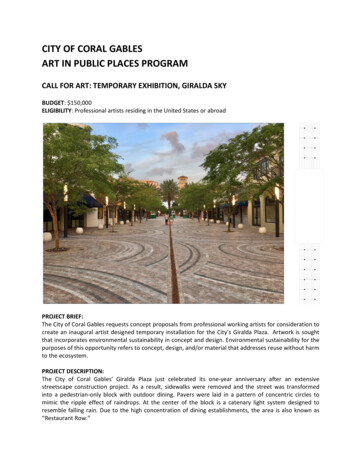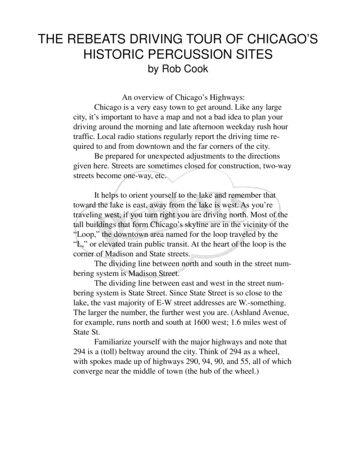
Transcription
Form No. 10-300, \Q-'{\P&UNITED STATES DEPARTMENT OF THE INTERIORNATIONAL PARK SERVICENATIONAL REGISTER OF HISTORIC PLACESINVENTORY -- NOMINATION FORMSEE INSTRUCTIONS IN HOWTO COMPLETE NATIONAL REGISTER FORMSTYPE ALL ENTRIES - COMPLETE APPLICABLE SECTIONSNAMEHISTORICFrank Norris's CabinAND/OR COMMONRedwood RetreatLOCATIONSTREET & NUMBER7155 L Redwood Retreat RoadNOT FOR PUBLICATIONCONGRESSIONAL DISTRICTCITY. TOWNGilroyxSTATEVICINITY OFCODECOUNTYHCLASSIFICATIONCATEGORYCODESanta ClaraCaliforniaOWNERSHIPSTATUSPRESENT USEDISTRICTPUBLIC- .OCCUPIED—AGRICULTURE—MUSEUMX-BUILDING(S) REBOTH—WORK IN PROGRESS—EDUCATIONALJxPRIVATE RESIDENCE—ENTERTAINMENT—RELIGIOUS—SITEPUBLIC ACQUISITION—OBJECTACCESSIBLE N PROCESS—YES: RESTRICTED—GOVERNMENT—SCIENTIFIC—BEING CONSIDERED—YES: ILITARY—OTHER:OWNER OF PROPERTYNAMEMrs. Ardis Dawn408-842-9767STREET & NUMBER7155 L Redwood Retreat RoadCITY. TOWNSTATEGilroyJL VICINITY OFCaliforniaLOCATION OF LEGAL DESCRIPTIONCOURTHOUSE.REGISTRY OF DEEDS,ETC.Santa Clara County Register of DeedsSTREET & NUMBERCITY. TOWNSTATECaliforniaSan JoseREPRESENTATION IN EXISTING LDEPOSITORY FORSURVEY RECORDSCITY. TOWNSTATE
DESCRIPTIONCONDITIONCHECK ONECHECK ONE—EXCELLENT—DETERIORATED UNALTERED ORIGINAL EDDATE.——————————DESCRIBE THE PRESENT AND ORIGINAL (IF KNOWN) PHYSICAL APPEARANCEThe alleged Frank Norris Cabin is a two-room, one-story log cabin withstone-buttressed porch. The cabin, surrounded by magnificent Redwoods;is unchanged and intact. A circular seat, built of native stone, standsnear the cabin and was erected by friends of the novelist as a memorialto him.The buildingthe cabin isrough canyonup the steepis occasionally used as a private summer residence. Access todifficult. A visitor must first hike up a private, narrow androad approximately one mile. Then on unmarked forest trail leadsmountain slope one more mile to the cabin area.
SIGNIFICANCEPERIODAREAS OF SIGNIFICANCE - CHECK AND JUSTIFY MMUNITY PLANNING—LANDSCAPE TIO N/SETTLEM E —POLITICS/GOVERNMENT—TRANSPORTATION—OTHER {SPECIFY)—INVENTIONSPECIFIC DATESBUILDER/ARCHITECTSTATEMENT OF SIGNIFICANCEBenjamin Franklin Norris has been called "the most stimulating and militant"of the early American naturalist writers.An intellectual child 'of the1890's Frank Norris's art reflects that sober period of American disillusionment and portrays the individual's loss of freedom and dignity in his strugglewith complex forces of modern society. Two of his novels, McTeague (1899) andThe Octopus (1901), still stand as great and distinguished landmarks in historyof American literature.HistoryNorris, Benjamin Franklin (Mar. 5, 1870-Oct. 25, 1902), journalist and novelist,known both in private life and in the literary world as Frank Norris, was bornin Chicago, 111., the son of Benjamin Franklin Norris and Gertrude (Doggett)Norris. His father, lame because of hip disease and consequently unfitted forthe severe toil of a Michigan farm, became at the age of fourteen unpaid assistant to a village watchmaker, learned the trade, saw something of the world asitinerant clock-mender and pedler, prospered, and ultimately founded his ownjewerly firm in Chicago. Frank's mother, born of mixed New England and Virginiaancestry on a Massachusetts farm, was before her marriage a teacher in the publicschools of Chicago and an actress who had enjoyed considerable success on theprofessional stage. Of their five children, but two, Frank and a brother, Charles,eleven years his junior, also destined to win distinction as a writer, survivedthe perils of infancy and childhood.In 1884, largely on account of the health of the elder Norris, the family movedto California, residing first at Oakland and a year later in San Francisco.Frank was sent to a school for boys at Belmont, some twenty miles south of thecity. In 1886 he was kept out of school for a time by a fracture of the leftarm, and to relieve the tedium of its convalescence he went to a local artistfor lessons in drawing. He showed such aptitude that his father resolved togive him the best opportunities for its development. In 1887 the parents tooktheir two sons first to London and then to Paris where Frank enrolled in theAtelier Julien. The family remained in Paris for more than a year and thenreturned to California, leaving the young artist to puruse his studies. Butthese studies came to an abrupt end in 1889 when the elder Norris, convinced,it is said, by the discovery of a serial romance with which Frank was entertaining his younger brother by mail, that his time in Paris was not being profitably employed, cabled him instructions to return home. The next year he
IMAJOR BIBLIOGRAPHICAL REFERENCESMildred Brooke Hoover, Hero Eugene Rensch and Ethel Grace Rensch, revised by Ruth Teiser,Historic Spots in California (Stanford, 1958), 348; Fred Lewis Pattee, The New AmericanLiterature, 1890-1930 (New York, 1930), 36-48; Franklin Walker, Frank Norris: A Biography(New York, 1932; Ernest Marchand, Frank Norris: a Study (Stanford, 1942);Robert E. Spiller, el al., Literary History of the United States - Bibliography (NewYork. 1948). 668-669: John W. Cauehev. California (New Jersey. 1957). 432-433.(BGEOGRAPHICALDATA———ACREAGE OF NOMINATED PROPERTYUTM REFERENCESA , IZONEIiI.EASTINGII.1»t.Bl,.11I.1.ZONE EASTINGDl . I I I . I .NORTHINGcl i I I I . I . t I I.I.I,,,I I.I.I.INORTHINGI r I . I.I,,IVERBAL BOUNDARY DESCRIPTIONFoundation lines of the structureLIST ALL STATES AND COUNTIES FOR PROPERTIES OVERLAPPING STATE OR COUNTY RM PREPARED BYNAME/TITLEOriginal form prepared bv Charles Snell; Revised by Marilvnn LarewDATEORGANIZATIONHCRSSTREET & NUMBERTELEPHONE3,43-6404440 G StreetCITY OR TOWNSTATEWashington. D.C.STATE HISTORIC PRESERVATION OFFICER CERTIFICATIONTHE EVALUATED SIGNIFICANCE OF THIS PROPERTY WITHIN THE STATE IS:NATIONALSTATELOCALAs the designated State Historic Preservation Officer for the National Historic Preservation Act of 1966 (Public Law 89-665), Ihereby nominate this property for inclusion in the National Register and certify that it has been evaluated according to thecriteria and procedures set forth by the National Park Service.STATE HISTORIC PRESERVATION OFFICER SIGNATURETITLEWt iKiiii SSDATE.GPO 892-453
FHR-8-250A (10/78)UNITED STATES DEPARTMENT OF THE INTERIOR.HERITAGE CONSERVATION AND RECREATION SERVICEurpcICpHMI Y:NATIONAL REGISTER OF HISTORIC PLACESINVENTORY-NOMINATION FORMCONTINUATION SHEETITEM NUMBER3PAGE 2definitely committed himself to literature rather than art by entering theUniversity of California. In college he exercised his talents on studentplays and class books, with an occasional story or poem. Having come underthe influence of Zola, whom he read with the devotion of a disciple, headopted realism as a creed and began the first chapters of a story of SanFrancisco to be later completed and published as McTeague. Prevented byunfulfilled requirements in mathematics from graduating with his class in1894, he spent the next year at Harvard, as a special student in English,electing among others a course in English composition with Lewis E. Gates,who recognized and encourag.ed his literary ambition. Parts of Vandover andthe Brute were written under this stimulus.In the autumn of 1895 Norris went to South Africa with credentials from theSan Francisco Chronicle, arriving just in time to become involved in Dr.Leander Starr Jameson's disastrous raid on Johannesburg. He was capturedby the Boers and ordered to leave the country. A severe attack of Africanfever prevented him from doing so at once, and he was not able to return toSan Francisco until the spring of 1896. There has was taken on the staffof a literary weekly known as the Wave and wrote dilegently for its columns."Moran of the Lady Letty," a tale of love and adventure at sea, based, it issaid, upon material secured from a sailor in the coast guard, was written atthis time. Within two years he was in New York City, where he was associatedwith McClure's Magazine. As correspondent for the same periodical he was inCuba during the Santiago campaign and suffered there a severe recurrence ofthe African fever. Upon his recovery he returned to New York and in 1899entered the service of Doubleday, Page & Company. He resumed his literarywork, the quality of which speedily won him recognition as a novelist ofunusual vigor and originality. Moran of the Lady Letty appeared in bookform in 1898 and McTeague and Blix in 1899. McTeague, which some regard ashis strongest work, is a tale of passion and violence, beginning in the officeof a charlatan dentist in the older section of San Francisco and ending inthe scorched distances of Death Valley. It is the stuff of romance realistically set forth in scenes new to most readers.A less successful novel, A Man's Woman, a story of love and arctic exploration, followed in 1900, and then began a more ambitious undertaking, his"Epic of the Wheat." This was to consist of "The Octopus," a story ofCalifornia and the growing of the wheat, "The Pit," a Chicago tale of wheatin the commerce of the world, and "The Wolf," which sould show the wheatconsumed as bread in some famine-stricken village of the old world. TheOctopus appeared in 1901. It was a novel with a purpose, an ardent defenseof the wheat-growers in their struggle against the dominating greed of theGPO 936-OO9
FHR-8-250A (10/78)UNITED STATES DEPARTMENT OF THE INTERIORHERITAGE CONSERVATION AND RECREATION SERVICENATIONAL REGISTER OF HISTORIC PLACESINVENTORY -NOMINATION FORMCONTINUATION SHEETITEM NUMBER 8:P R HCRS U5E NLYDAT bENTEREDPAGE3the railroad trust, and through it ran the epic story of the life-givingwheat, impersonal and irresistible, in the end engulfing the odious figureof the railway agent. The Pit was posthumously issued in 1903, and as anovel and as a play enjoyed a great success. A collection of essays, TheResponsibilities of the Novelist, was published in the same year and Vandover and the Brute in 1914.Norris was married Jan. 12, 1900, to Jeanette Black of California, and onechild, a daughter, was born to them. Blix is said to be in some degree thestory of his own wooing and of his struggle for literary recognition. Hedied in a hospital in San Francisco of peritonitis follwing an operation forappendicitis. He had returned to California in 1902 and had purchased aranch near Gilroy, intending to make it his home. A projected trip to Indiafor material for "The Wolf" and a second trilogy, to deal with the battle ofGettysburg, were frustrated by his death, which brought to a close a life ofreal literary promise. His works were published in collected editions in 1903and 1928.GPO 936-009
the perils of infancy and childhood. In 1884, largely on account of the health of the elder Norris, the family moved to California, residing first at Oakland and a year later in San Francisco. Frank was sent to a school for boys at Belmont, some twenty miles south of the city. In 1886 he wa











